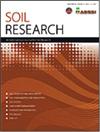在降雨模拟器下,农药从土壤中提取到径流中
IF 1.5
4区 农林科学
Q4 SOIL SCIENCE
引用次数: 0
摘要
径流估算是农药环境行为的一个重要方面,是农药对环境的主要损失途径。目的提高对农药径流的认识。方法采用三个降雨模拟试验的数据。所研究的12种农药从紧密吸附型(DDE,土壤吸附系数(KD) ~15 000 L kg−1)到弱吸附型(乐果,KD <30)。事件径流农药浓度与土壤浓度密切相关(0 ~ 25 mm深度)。对于具有广泛吸附范围的农药,在三种土壤中,径流与土壤浓度的比值(径流提取比,ERO)相似:径流浓度(μg L−1)= 28 ×土壤浓度(mg kg−1)。喷施后,ERO随着时间的推移而下降,可能是由于土壤顶部几毫米的浓度较低。与以前的模型相比,该模型提供了改进的或类似的农药径流估计。地点之间相似的ERO值可能是由于相似的水文(高降雨强度、地表密封、潮湿的底土)和侵蚀,以及参与混合的土壤和水的质量相同。由于入渗量小,土壤吸收量太高,淋滤对径流浓度的降低没有影响。所研究的条件在夏季风暴期间适用于澳大利亚东部北部谷物和棉花地的粘土上的大多数棉花和谷物地。该模型应适用于这些条件。本文章由计算机程序翻译,如有差异,请以英文原文为准。
Pesticide extraction from soil into runoff under a rainfall simulator
Context Runoff estimation is an important aspect of pesticide environmental behaviour and is the major loss pathway to the environment. Aims To improve understanding of pesticide runoff. Methods Data from three rainfall simulator studies was used. Twelve pesticides were studied ranged from tightly sorbed (DDE, soil sorption coefficient (KD) ~15 000 L kg−1) to weakly sorbed (dimethoate, KD < 30). Key results Event runoff pesticide concentrations were closely related to soil concentrations (0–25 mm depth). The ratio of runoff to soil concentration (the runoff extraction ratio, ERO), was similar for pesticides with a wide range of sorption and across the three soils: runoff concentration (μg L−1) = 28 × soil concentration (mg kg−1). ERO decreased with time after spraying, presumably due to lower concentrations in the top few mm of soil. Conclusions This model provides improved or similar estimates of pesticide runoff than previous models. Similar ERO values between sites was probably due to similar hydrology (high rainfall intensity, surface sealing, moist subsoils) and erosion, and because the same masses of soil and water are involved in mixing. Reduction in runoff concentrations by leaching was not influential, because infiltration was small and soil sorption too high. Implications Conditions studied apply during summer storms on most cotton and grain land on clay soils in the northern grain and cotton lands in eastern Australia. The model should be applicable under these conditions.
求助全文
通过发布文献求助,成功后即可免费获取论文全文。
去求助
来源期刊

Soil Research
SOIL SCIENCE-
CiteScore
3.20
自引率
6.20%
发文量
35
审稿时长
4.5 months
期刊介绍:
Soil Research (formerly known as Australian Journal of Soil Research) is an international journal that aims to rapidly publish high-quality, novel research about fundamental and applied aspects of soil science. As well as publishing in traditional aspects of soil biology, soil physics and soil chemistry across terrestrial ecosystems, the journal welcomes manuscripts dealing with wider interactions of soils with the environment.
Soil Research is published with the endorsement of the Commonwealth Scientific and Industrial Research Organisation (CSIRO) and the Australian Academy of Science.
 求助内容:
求助内容: 应助结果提醒方式:
应助结果提醒方式:


